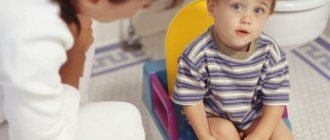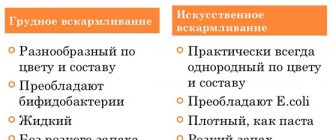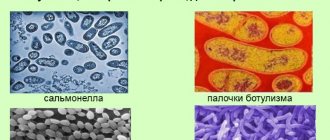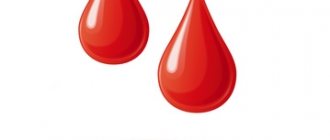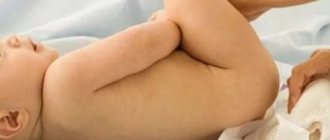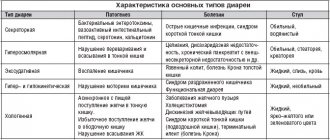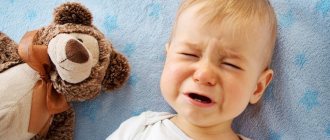Causes
The reasons why you may find blood in the stool during diarrhea in a child are divided into three groups. This symptom may be due to:
- Food
- Disease
- External factors
Nutrition
- Severe food poisoning
- Excess of low-quality harmful products (soda, chips, fast food)
- A lot of vegetables and fruits were eaten, especially those that were not fully ripe
Diseases
- In the intestines, pathogenic microflora prevails over beneficial ones
- Intestinal infection: salmonellosis, rota virus, enterovirus, dysentery
- Diseases of the gastrointestinal tract: gastritis, colitis, peptic ulcers
- Inflammation of the mucous membrane of the stomach, esophagus, intestines
- Internal hemorrhoids
- Dysbacteriosis
- Allergic reactions
- Cancers
- Lactase or enzyme deficiency
- Crohn's disease
- Damage to the body by helminths
External factors
- Entry into the stomach or esophagus of a foreign body, which (especially if it has sharp edges) can injure the mucous membrane
- Unsuccessful operation
- Stressful situations
- Taking certain medications (such as antibiotics)
Of course, the first thing to do if a child has bloody diarrhea is to call a doctor. But you shouldn’t sit idly by until the specialist arrives. For example, it is worth paying attention to the accompanying symptoms. They will help you get a rough picture of the disease.
When to see a doctor
Treatment of bleeding is carried out in a hospital or at home. But self-diagnosis and choice of drugs increases the risk of an unfavorable outcome or the development of complications.
When to call a doctor:
- diarrhea with blood without fever in an infant or one-year-old child;
- a single episode in a baby under 6 months;
- increased temperature accompanied by loose stools;
- the presence of any inclusions in the stool - blood, mucus, undigested food;
- the baby began to diarrhea after taking medications;
- the appearance of a rash against the background of bloody diarrhea;
- there is uncontrollable vomiting, abdominal pain;
- There is general intoxication, weakness, and signs of dehydration.
Any fact of repeated diarrhea in a child is a reason to contact a medical facility. Only a person who is professionally involved in medicine should identify the cause of the pathology or reassure the parents.
Associated symptoms
Temperature
- If a child has diarrhea with blood and fever, this is a symptom of an intestinal infection. In addition to the characteristic stool, in this case the baby may experience weakness, headache, vomiting, and severe pain in the abdominal area.
- Diarrhea with blood in a child without fever indicates that there is no source of infection or inflammation in the small body. But, one way or another, you shouldn’t relax, because without fever or with it, diarrhea with blood in a little person, and even more so in an infant, is a very dangerous condition.
Blood color
The color of the blood can determine the site of bleeding.
- If an infant or older child has diarrhea with streaks of bright scarlet blood, this indicates that the bleeding is in the intestines. The blood has not had time to clot, which is why it has a bright red color.
- Also, diarrhea with streaks of blood of this color in a child may indicate formations in the rectum - polyps, tumors, hemorrhoids
- If a child has loose stools with dark streaks of blood, a gastric or duodenal ulcer can be suspected. Although, of course, such diseases are rare in children.
Slime
Diarrhea in a child with blood and mucus is sometimes regarded by experts as a harbinger of an incipient rota virus (also known as intestinal flu) or enterovirus. This is only the first symptom; then the disease will manifest itself in the form of headache, pain, runny nose, and fever.
If the color of the mucus is unusual, for example, there are orange or green specks in the stool, you can assume either coli infection or salmonellosis.
Itching
If your baby complains that the anus is very itchy, also tell the doctor about it. This symptom indicates the presence of parasites, as well as internal and external hemorrhoids.
Vomit
If your baby is sick, you may suspect food poisoning, an intestinal infection, or a viral disease. This means that a serious malfunction has occurred in the functioning of the entire digestive system.
On the topic: vomiting and diarrhea in a child
Before you panic because your baby has bloody diarrhea, take another close look at the feces, and at the same time remember what your baby ate the day before. It is likely that there are not bloody streaks in the stool, but rather harmless undigested tomatoes or beets. If you are not mistaken and there is still blood in the stool, we urgently call a doctor, and while he is on his way, we try to alleviate the child’s condition on our own.
Diarrhea and other symptoms
Before the doctor arrives, parents should assess the child’s condition themselves and take some first aid measures. But this will require establishing the suspected cause of diarrhea. Learn more about accompanying symptoms.
Blood color
The first thing you need to pay attention to is the color of the stool. It is advisable to leave the contents of the diaper or potty until the doctor arrives. This information will help your pediatrician make a diagnosis.
- black, tarry stools indicate bleeding in the upper digestive tract (hydrochloric acid in the stomach neutralizes hemoglobin in the blood, promoting the formation of insoluble maroon-colored salts);
- fresh streaked blood may indicate pathology of the main part of the large intestine (colon);
- feces with mucus and blood of a “fatty” consistency occur with chronic intestinal diseases and infectious lesions of the gastrointestinal tract;
- the presence of drops of blood only on the surface of the stool indicates the presence of rectal fissures or internal hemorrhoids.
We recommend: A child has diarrhea - causes and first aid
Body temperature
Bloody, mucous stool accompanied by vomiting, abdominal pain and high fever are signs of an intestinal infection. What to do in this situation can only be advised by the attending physician based on the results of tests that have identified the causative agent of the disease.
Loose stools without fever reject suspicions of infection or inflammation. But this is not a reason to refuse to consult a doctor, since we are talking about hidden pathologies of internal organs, which is no less dangerous for the child.
Itching
A child's complaints of itching in the posterior region with diarrhea mixed with blood usually indicates rectal diseases, including the formation of hemorrhoids in the inner part of the rectum.
First aid
- If possible, try to save feces with dangerous inclusions until the doctor arrives. This will help him quickly assess the picture of the disease and make the correct diagnosis.
- You should not try to feed the baby, it will not do him any good. The maximum that can be offered to a child in this condition is white bread crackers and carrot puree diluted with water.
- But be sure to give your baby something to drink. Dehydration with diarrhea can occur very quickly, and this is a very dangerous condition that can lead to serious health problems, including death. So, let’s give the child plenty of clean water. Ideally (especially if the baby is nauseous) it would be to give him something to drink little by little (10-15 mg), but often (every 5 minutes).
- Water can (and even should) be replaced with a water-salt solution, for example, Regidron or Oralit. Such solutions not only prevent the onset of dehydration, but also replenish beneficial salts, which during diarrhea do not have time to be absorbed in the intestines, but are washed out along with water. A water-salt solution can be prepared at home. To do this, per liter of water you need to take two tablespoons of sugar, two teaspoons of salt and half a teaspoon of baking soda.
- If the baby has a high temperature, and there is still a long time before the doctor arrives, you need to bring it down. For this purpose, use any antipyretic drugs based on paracetamol that are appropriate for your age.
- Wash your baby thoroughly after each attack of diarrhea.
- Do not give your baby any medications other than antipyretics. However, sorbents and preparations that will help cleanse the child’s body of harmful substances and toxins are also acceptable. Sorbents include Smecta, Enterosgel, Polyphepam, Polysorb. Choose a product based on the child’s age.
- If the doctor suspects an intestinal infection, be prepared to take your baby to the hospital. Therefore, it will not be superfluous to prepare all the documents and things necessary for the first time.
Possible complications
The lack of qualified assistance or the provision of incomplete assistance to a child complaining of diarrhea can have serious consequences. The slightest negligence in this matter significantly increases the risk of disability in a small patient and even death. Also recommends reading: the danger of bloody diarrhea in adults.
Most likely complications:
- Dehydration, which provokes the development of convulsions and loss of consciousness. A 10% decrease in fluid levels in the body is already a severe condition, followed by a long recovery period. If the fluid loss is 20%, the child does not survive. Sometimes for kids the figure of 10% is already critical.
- Chronic intestinal disorder, characterized by frequent bowel movements and constant flatulence.
- Dysbacteriosis due to antibacterial therapy in the treatment of infectious diarrhea.
- Rectal prolapse as a result of insufficient medical intervention and incomplete treatment for dysentery.
Video: Blood in a child’s stool, what to do?
And this is not a complete list of the terrible consequences that may threaten your sick child.
We recommend: Diarrhea with mucus in a small child - causes and treatment of the problem
Treatment
- In the event that diarrhea mixed with blood in a child is caused by diseases of the gastrointestinal tract, treatment can only be carried out in a hospital, under the supervision of a qualified specialist
- If a child has loose, bloody stools as a result of an intestinal infection, treatment is prescribed depending on the pathogen. If it is bacteria, antibiotics are prescribed; if it is viruses, antiviral drugs are prescribed.
- In any case, agents are prescribed that restore the water-salt balance, as well as sorbents
- In case of inflammation (for example, colitis), treatment is mainly carried out with anti-inflammatory drugs
- If normalization of disturbed intestinal microflora is required, the doctor will prescribe prebiotics, lactobacilli and bifidobacteria (Linex, bifidumbacterin, Hilak-forte)
Find out more about how to stop diarrhea in a child in our other article.
Treatment of bloody diarrhea in a child
If blood appears in the child's loose stool, a doctor's intervention will be required. Whether it will be a gastroenterologist, a pediatrician or an infectious disease specialist will be determined by the test results.
If a child is diagnosed with an infection, treatment will begin with isolating him from contact with other people. If we are not talking about an infection, then treatment is carried out on an outpatient basis, but an inpatient option is also possible if the inflammatory process progresses in the intestines of a child (who is under one year old).
As for treatment methods, drug therapy and limited nutrition, that is, diet, are effective.
Treatment with drugs
For drug treatment, the following drugs are prescribed:
- a course of antibiotics for infectious diseases (for nonspecific infections “Amoxicillin”, “Amoxiclav”, “Penicillin”, “Tetracycline”);
- bifidobacteria and lactobacilli, normalizing intestinal microflora;
- “Smecta”, “Enterosgel” and other drugs of similar action are prescribed as adsorbents that remove toxins from the body and normalize the child’s stool;
- Vasoprotectors are included in the course of treatment for hemorrhoidal inflammation.
Water, compotes, fruit drinks, and mineral water are necessary to restore the body’s water balance, since a significant amount of fluid is excreted along with diarrhea.
Surgical intervention is also possible:
- hemorrhoids are removed by radial incision;
- protrusions and stacks of the colon (diverticula) are removed in the same way as appendicitis;
- Intestinal obstruction is also eliminated; the specific method is chosen depending on the complexity of the situation.
Diet
Until diarrhea, especially with blood, is cured, the child’s diet should be limited so as not to provoke the formation of new loose stools. The diet includes the following:
- eliminating from the diet foods that provoke a laxative effect, such as milk and kefir, fruits, some types of vegetables (for example, beets, pumpkin);
- legumes and sweets should also be excluded during treatment;
- The child’s diet should include rice and bananas, which form solid feces, as well as crackers;
- if an infant has diarrhea with blood, then the nursing mother should adhere to a strict diet;
- Vegetables and fruits allowed for consumption must be thoroughly washed.
Pre-medical actions
As soon as parents discover the presence of blood in their child’s diarrhea, they need to immediately call an ambulance. Before the doctor arrives, the child needs to have their body temperature measured. An older child should be asked if he has swallowed small non-food items (perhaps the appearance of blood is caused by this very factor).
The child must be kept calm by placing him on the bed until the doctors arrive.
ethnoscience
Traditional medicine methods do not always bring a 100% effect, but many use them to make a child feel better. However, if blood or its components are found in diarrhea, then it is recommended to abandon folk remedies.
The following tinctures have shown their effectiveness in folk treatment:
- from walnut partitions;
- from oak bark;
- from blueberries.
If blood in loose stool is a consequence of an anal fissure or hemorrhoids, it is recommended to give the child a decoction of rose hips, which has a hemostatic effect.
Diet
As we have already said, while the malaise is in an acute stage, it is best for the child to fast. How to organize his nutrition next?
- All foods that are difficult to digest are completely excluded from the diet. This is salted, smoked, fatty, spicy, canned. You should also not eat foods that cause increased gas formation. These are mushrooms, nuts, all legumes. Food should be as gentle as possible.
- Include foods that have a strengthening effect in your menu. These are bananas, rice, jelly
- If the baby is breastfed, then the mother must follow a strict diet that excludes all the foods we talked about above
- If your baby is bottle-fed, it would be a good idea to switch to a lactose-free (soy) formula for a while.
Prevention
Instead of restoring the child’s health for a long time, it would be much better to prevent the disease altogether. It’s not that difficult, the main thing is to follow a few very important preventive measures:
- Your baby's nutrition should be appropriate for his age. Chips, fast food and smoked sausage will do nothing but harm to an adult, but for a child this diet is simply destructive
- Take care of your baby's hygiene. His toys, bottles, and pacifiers must be carefully processed. If we are talking about older people, teach your child to wash their hands before eating and after using the restroom.
- Wash vegetables and fruits
- Boil the water
- Avoid visiting crowded places with your child
- Do not allow him to swim in unknown lakes and ponds
- Strengthen your immune system, and then diseases will bypass your baby.

